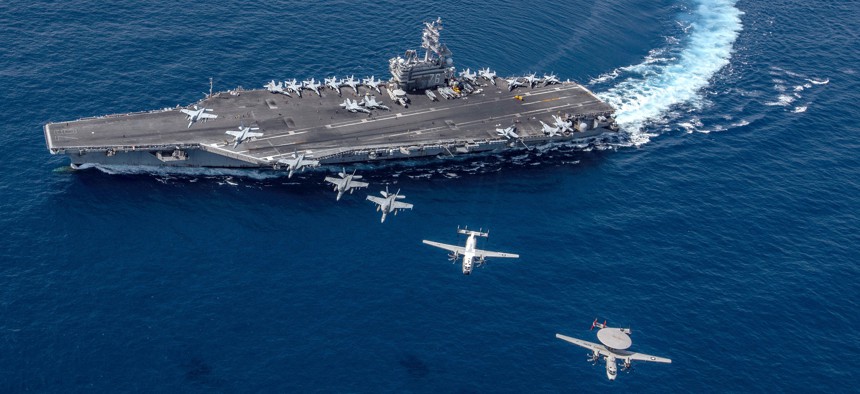
Multiple aircraft from Carrier Air Wing 5 fly in formation over the Navy’s forward-deployed aircraft carrier USS Ronald Reagan. U.S. Navy photo by Mass Communication Specialist 2nd Class Kaila V. Peters
4 C’s Drive Biden Administration’s First Naval Strategic Guidance
“Expanded” posture is needed to focus on China, Navy Secretary Del Toro writes.
The “Four C’s: China, Culture, Climate Change, and COVID” are the naval services’ “most pressing” challenges, Carlos Del Toro writes in his first strategic guidance as the Biden administration’s first Navy secretary. But just one of them is the “pacing challenge” that should be the focus of planning and spending.
“The People’s Republic of China represents the pacing challenge against which we must plan our warfighting strategies and investments,” Del Toro wrote in his new strategic guidance. “For the first time in at least a generation, we have a strategic competitor who possesses naval capabilities that rival our own, and who seeks to aggressively employ its forces to challenge U.S. principles, partnerships, and prosperity.”
Released on Thursday, the guidance is meant to bring the Navy and Marine Corps together with a common vision from the new Navy secretary as well as the Biden administration’s other priorities like COVID and climate change, said Bryan Clark, a senior fellow at the Hudson Institute, who participated in a workshop to help develop the guidance.
Mackenzie Eaglen, a senior fellow at the American Enterprise Institute, said Del Toro’s new guidance lacks the candor of his Oct. 5 speech at the U.S. Naval Academy in Annapolis, Maryland. In that speech, he said that China has naval capabilities that “in some areas, even surpass our own.”
Eaglen found the guidance “milquetoast” and said it is heavy on investments in everything except ships.
“While there is little to disagree with – except a shrinking Navy – there is also little new,” she said in an email. “In summary, SecNav is delineating his priorities: new concepts and capabilities (technology) over capacity (hulls) to bolster deterrence over warfighting. This is in line with general DoD guidance and budget choices from [secretary of defense] on down.”
Although the guidance does not explicitly mention buying and building more ships, it does say that the Navy will expand its global posture.
“We will continue to promote sustained, persistent mobile operations forward. We will make tough decisions to maximize precious resources, ensuring our future naval supremacy against the full spectrum of potential threats, while seeking additional resources to support our increasing responsibilities in the Indo-Pacific region. It will be essential for us to set our naval posture forward to be able to effectively transition from competition to crisis to conflict as needed,” Del Toro wrote.
The guidance does not say how many ships will be needed. The Pentagon has yet to release the force posture review that is expected to signal where troops and resources will be repositioned around the world. Defense Secretary Lloyd Austin has also not released his new National Defense Strategy, which this guidance is meant to support.
Clark found the inclusion of developing warfighting concepts and capabilities a good idea for how the Navy will need to deter and compete with China as a near-peer challenge operating in all domains like on the sea, under the sea, and in cyberspace.
“We've been up against smaller adversaries for so long, I think the U. S. got used to being dominant and being able to basically push people around. And so up against China, it's a peer, you've got to really be creative and come up with new ways to deter China, you can't just rely on having an overpowering military like we did against Iraq, or Afghanistan, or Kosovo,” he said.
The guidance will inform choices to make in the upcoming 2023 and 2024 budget requests, which have become more restrictive. Del Toro says the department will have to make “tough and sometimes unpopular choices” and prioritize its capabilities around China while also having to find ways to increase efficiencies and savings.
Eaglen pointed to a number of investments that the secretary highlighted, including critical infrastructure, industrial workforce, and sustainable fuels.
“Many of these priorities are overdue and important (i.e., industrial workforce investment), but Congress will ultimately not be pleased with yet another budget that shrinks the Navy when it’s demands are growing. Even SecNav admits as much in the guidance calling for expanded forward naval presence,” she wrote—emphasis hers.




